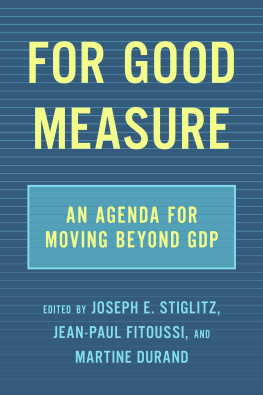ALSO BY JOSEPH E. STIGLITZ
Freefall: America, Free Markets, and the Sinking
of the World Economy
Globalization and Its Discontents
Making Globalization Work
The Roaring Nineties: A New History of the Worlds
Most Prosperous Decade
The Stiglitz Report: Reforming the International Monetary and
Financial Systems in the Wake of the Global Crisis
The Three Trillion Dollar War: The True Cost of the Iraq Conflict
(with Linda J. Bilmes)
CLASSICAL GDP ISSUES
Introduction
Gross domestic product (GDP) is the most widely used measure of economic activity. There are international standards for its calculation, and much thought has gone into its statistical and conceptual bases. But GDP mainly measures market production, though it has often been treated as if it were a measure of economic well-being. Conflating the two can lead to misleading indications about how well-off people are and entail the wrong policy decisions.
One reason why money measures of economic performance and living standards have come to play such an important role in our societies is that the monetary valuation of goods and services makes it easy to add up quantities of a very different nature. When we know the prices of apple juice and DVD players, we can add up their values and make statements about production and consumption in a single figure. But market prices are more than an accounting device. Economic theory tells us that when markets are functioning properly, the ratio of one market price to another is reflective of the relative appreciation of the two products by those who purchase them. Moreover, GDP captures all final goods in the economy, whether they are consumed by households, firms or government. Valuing them with their prices would thus seem to be a good way of capturing, in a single number, how well-off society is at a particular moment. Furthermore, keeping prices unchanged while observing how quantities of goods and services that enter GDP move over time would seem like a reasonable way of making a statement about how societys living standards are evolving in real terms.
As it turns out, things are more complicated. First, prices may not exist for some goods and services (if for instance government provides free health insurance or if households are engaged in child care), raising the question of how these services should be valued. Second, even where there are market prices, they may deviate from societys underlying valuation. In particular, when the consumption or production of particular products affects society as a whole, the price that individuals pay for those products will differ from their value to society at large. Environmental damage caused by production or consumption activities that is not reflected in market prices is a well-known example.
There is yet another problem. While talking about the concepts of prices and quantities might be straightforward, defining and measuring how they change in practice is an altogether different matter. As it happens, many products change over timethey disappear entirely or new features are added to them. Quality change can be very rapid in areas like information and communication technologies. There are also products whose quality is complex, multidimensional and hard to measure, such as medical services, educational services, research activities and financial services. Difficulties also arise in collecting data in an era when an increasing fraction of sales take place over the internet and at sales as well as discount stores. As a consequence, capturing quality change correctly is a tremendous challenge for statisticians, yet this is vital to measuring real income and real consumption, some of the key determinants of peoples well-being. Underestimating quality improvements is equivalent to overestimating the rate of inflation, and therefore to underestimating real income. For instance, in the mid-1990s, a report reviewing the measurement of inflation in the United States (Boskin Commission Report) estimated that insufficient accounting for quality improvements in goods and services had led to an annual overestimation of inflation by 0.6%. This led to a series of changes to the U.S. consumer price index.
The debate in Europe has tended to go the opposite way: official price statistics have been criticized for underestimating inflation. This has been partly because peoples perception of inflation differs from the national averages presented in the consumer price index, and also because it is felt that statisticians overadjust for quality improvements in products, thereby painting too rosy a picture of citizens real income.
For market prices to be reflective of consumers appreciation of goods and services, it is also necessary that consumers are free to choose and that they dispose of the relevant information. It takes little imagination to argue that this is not always the case. Complex financial products are an example where consumer ignorance prevents market prices from playing their role as carriers of correct economic signals. The complex and ever-changing bundles of services offered by telecommunications companies are another case in point where it is difficult to ensure the transparency and comparability of price signals.
All the above considerations imply that price signals have to be interpreted with care in temporal and spatial comparisons. For a number of purposes, they do not provide a useful vehicle for the aggregation of quantities. This does not imply that the use of market prices in constructing measures of economic performance is generally flawed. But it does suggest prudence, in particular with regard to the often overemphasized measure, GDP.
This chapter suggests five ways of dealing with some of the deficiencies of GDP as an indicator of living standards. First, emphasize well-established indicators other than GDP in the national accounts. Second, improve the empirical measurement of key production activities, in particular the provision of health and education services. Third, bring out the household perspective, which is most pertinent for considerations of living standards. Fourth, add information about the distribution of income, consumption and wealth to data on the average evolution of these elements. Finally, widen the scope of what is being measured. In particular, a significant part of economic activity takes place outside markets and is often not reflected in established national accounts. However, when there are no markets, there are no market prices, and valuing such activities requires estimates (imputations). These are meaningful, but they come at a cost, and we shall discuss them before turning to the other proposals.
ImputationsComprehensiveness Versus Comprehensibility
Imputations exist for two related reasons. The first is comprehensiveness. There are productive activities and associated income flows (typically non-monetary) that take place outside the market sphere, and some of them have been incorporated into GDP. The single most important imputation is a consumption value for the services that home-owners derive from living in their own dwellings. There is no market transaction and no payment takes place, but the national accounts treat this situation as if home-owners paid a rent to themselves. Most people would agree that if two persons receive the same money income but one of them lives in his/her own house while the other rents, they are not equally well-offhence the imputation in order to better compare incomes over time or between countries. This brings us to the second reason for imputations, the invariance principle: the value of the main accounting aggregates should not depend on the institutional arrangements in a country. For example, if exactly the same medical services are provided in one case by the public sector and in another case by the private sector, overall measures of production should be unaffected by a switch between the two institutional settings. The main advantage of adhering to the invariance principle is better comparability over time and between countries. Therefore, for instance, measures of adjusted disposable income for households (see below) include an imputation for government services provided directly to citizens.












